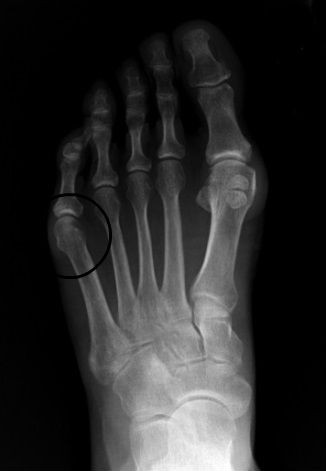What is a Tailor’s Bunion?
Tailor’s bunion is similar to bunion deformity but it develops on the opposite side of the foot over 5th metatarsophalangeal joint (5th MPJ). This produces a painful pressure area and its symptoms include pressure pain, painful callous formation and difficulty wearing shoes.
What causes a Tailor’s Bunion?
- Biomechanical abnormality: If there is excess motion in one part of the foot when stability is needed, changes in foot structure can occur. The gradual separation between the metatarsal bones that leads to a bunion is an example of this.
- Hereditary: Genetic factors play a role in predisposing some people to develop Tailor’s bunion.
- Footwear: Poor shoes–like high heels and pointed toe boxes–exacerbate the condition by speeding up the development of Tailor’s bunion, by making them more painful. This is at least one of the reasons Tailor’s bunion is much more common in women than men.

Conservative Treatments
Conservative treatments aim to reduce pressure over the painful area but not necessarily mean correction of the deformity.
- Padding: Padding over the painful area may help relieve some of the pressure and reduce pain
- Footwear modification: Obtaining proper shoes that will accommodate the width of the forefoot will reduce pressure from shoes and reduces pain
- Orthoses: Correcting abnormal biomechanics of the foot may help relieve pain
- Non-steroidal anti-inflammatories: If the source of pain is bursitis, taking NSAIDs may help pain relief
- Steroid injection
Surgical Treatments
Do I need surgery?
Similar to bunion deformity, whether you require a surgery or not is purely your choice. However, Tailor’s bunion is also progressive and it will not improve by itself, and if your tailor’s bunion prevents normal daily activities/shoes no longer fit properly or excessive pain with tailor’s bunion, you may consider it.
What does surgery involve?
There are quite a number of procedures designed to address a Tailor’s bunion, and each has different indications. Typically Tailor’s bunion surgery involve:
- Ostectomy: Removal of a painful bump from the head of 5th metatarsal
- Osteotomy: Cutting the fifth metatarsal bone and realigning it with fixation
- Removal of painful bursa: If present, removal of painful bursa may be warranted
- Anaesthetics: Various anaesthetics are available (General or spinal block or local anaesthetics with sedation)
The operation usually takes 45 – 60 minutes
After Tailor’s Bunion Surgery
- Keep your foot elevated as much as possible and apply an ice pack for the first week following surgery
- Your dressing will be changed between 3-7 days at the office after surgery
- Keep your dressing dry for the first 2 weeks after surgery
- Sutures will be removed between 2-3 weeks after surgery
- You are able to weight-bear on the heel in the postop surgical shoes
- You need expect to wear postop surgical shoes for 4-6 weeks


